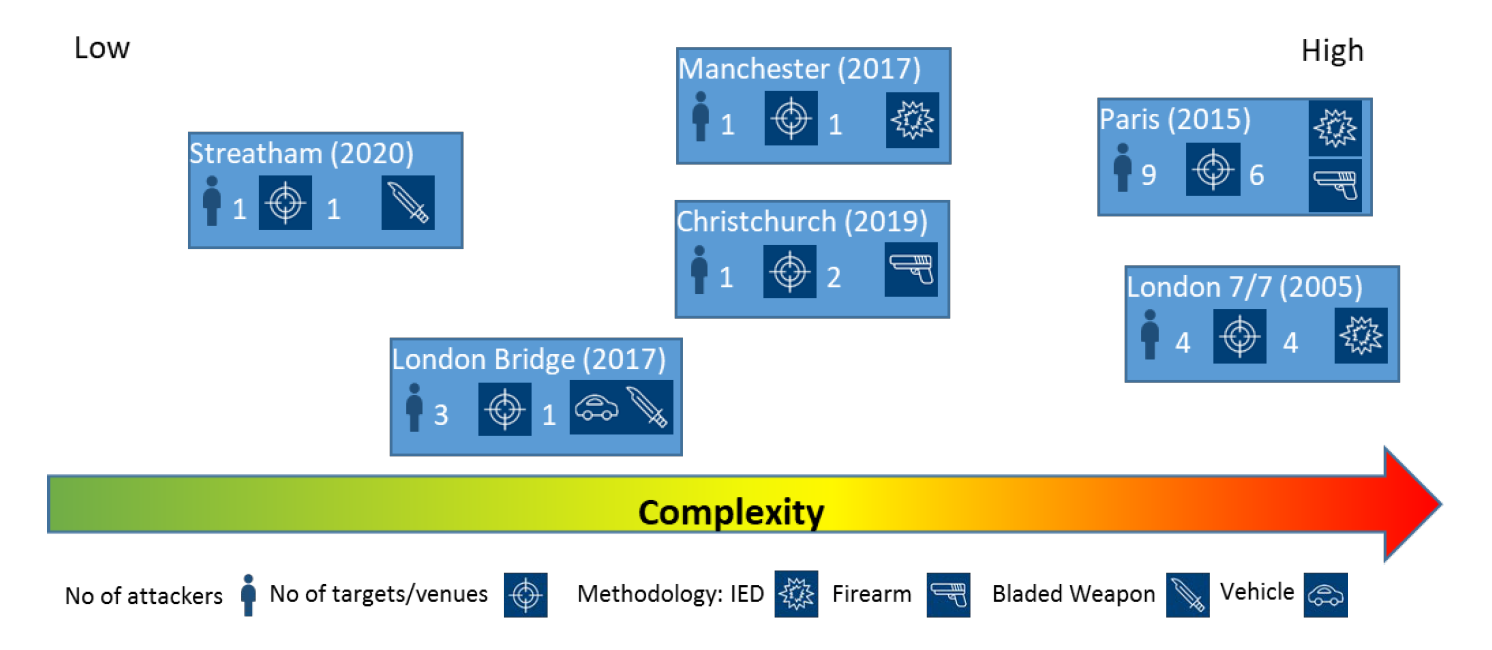What is a Complex Terrorist Attack?
There is no formal definition of what constitutes a ‘complex attack’. Terrorist attacks exhibit varying degrees of complexity – from high to low – depending on a number of characteristics. Characteristics of the most complex terrorist attacks include the use of well-prepared, well-trained and well-armed attackers, adopting military-style tactics, as well as striking multiple targets in a co-ordinated way.
Headline Assessment
Attacks of high complexity in the UK are rare. The most complex, completed attack in recent years was in 2017 when a suicide attacker detonated an IED at the Manchester Arena, killing 22 and injuring a further 116.
High complexity terrorist attacks in the West have been committed by those following an Islamist extremist ideology and have been directed or enabled by terrorist groups overseas. More complex attacks can also be carried out by Self-Initiated Terrorists (S-ITs) inspired by an ideology.
What is terrorist attack complexity?
There is no formal or universally agreed definition of what constitutes a ‘complex attack’. It can be argued that all terrorist attacks exhibit varying degrees of complexity. Low complexity attacks are considered those typically carried out by a lone attacker, employing a simple methodology against a single target. Conversely, attacks of higher complexity are acts of terrorism that exhibit particular characteristics, which can include one or more of the following:
-
multiple targets are struck by multiple attackers either simultaneously or in close succession
-
employs well-armed and well-trained individuals employing military or law enforcement style tactics
-
timings and methods are coordinated with other attackers and those providing assistance to the attackers
-
attackers strike quickly and move to another location before law enforcement can interdict and disrupt
-
access to victims and first responders is delayed or denied by use of diversions, obstructions or booby-traps to delay law enforcement response
-
secondary attacks are conducted on first responders, evacuation routes, and/or sites that are part of the response
-
significant levels of planning and preparation such as researching methodologies and targets, training, establishment of covert facilities and hostile reconnaissance
Because of these factors, it is difficult to describe an attack as simply ‘complex’ or ‘not complex’. Therefore, it is more accurate to ascribe a level of complexity for an attack such as high, medium or low.
The following graphic shows examples of attacks assessed for their relative levels of complexity.

The attacks in Streatham (2020) and London Bridge (2017) are considered low-complexity due to the fact that in each case only one attack cell was involved, targeting a single venue and using a simple methodology. At the other end of the scale is the marauding attack in Paris and the 7/7 London bombings, both of which involved groups of well-prepared and trained operatives attacking multiple targets in a co-ordinated way. Examples of medium-complexity attacks, lying between the two extremes, are the attacks in London in 2017 and Christchurch in 2019. Although both of these involved only single attackers, there was likely a greater degree of planning and preparation required.
How does complexity differ from sophistication?
Complexity should not be confused with the level of sophistication associated with a particular methodology. Where complexity refers to how the attack is conducted, sophistication describes the attack methodology used. A sophisticated methodology, such as a home-made explosive, could be used in a low complexity attack, and vice versa. Sophisticated methodologies require greater levels of preparation, knowledge and skill.
What is the difference between a complex terrorist attack and a marauding terrorist attack?
A marauding terrorist attack (MTA) shares many of the characteristics of a complex terrorist attack. MTAs are fast-moving, violent attacks where assailants move through a location aiming to find and kill or injure as many people as possible. However, depending on the number of attackers and the methodology used, not every MTA will be complex. For example an attack involving a single marauding attacker using a knife would not be classified as complex.
How do complex terrorist attacks manifest in the UK?
Attacks of high complexity in the UK are rare. The most complex successful attack in recent years was in 2017 when a suicide attacker detonated an IED at the Manchester Arena, killing 22 and injuring a further 116. However, it has become clear that Salman did not act alone. On 20th August 2020 the attacker's brother was sentenced to 55 years imprisonment for his part in planning the attack, having been found guilty of 22 counts of murder.
Over the last twenty years complex terrorist attacks in the West have been committed by those following an Islamist extremist ideology and have been directed or enabled by terrorist groups overseas. However, more complex attacks can also be carried out by self-initiated terrorists (S-ITs) inspired by an ideology.
What does this mean for UK Businesses and the public?
By their very nature, higher complexity attacks will almost certainly have a greater impact on business and the public than other types of attacks, given that attackers nearly always target civilians at multiple locations as they move through busy city centres. This impact can be compounded by the difficulties of planning for and implementing an effective multi-disciplinary response, at the required scale and at multiple locations. Nevertheless, as with all types of terrorist attacks, the public and business community have a vital role in alerting the authorities to suspicious activity that may be the prelude to a terrorist attack.
Probability and Likelihood in Intelligence Assessments
When describing threats in intelligence assessments, Counter Terrorism Policing utilises the Probabilistic Yardstick.
The Probabilistic Yardstick is a tool created by the Professional Head of Intelligence Analysis (PHIA), in the UK government, to standardise the way in which we describe probability in intelligence assessments. For example, if we use the term ‘likely’ what we mean is ‘a 55-75% chance’.
Use the scale below as a reference when reading ProtectUK Insights.


